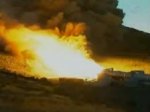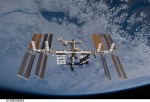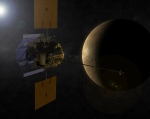The latest edition of “This Week In Space” is out!
Hello and Welcome. This week we have everything from NASA creating vomit in a lab to fire and smoke, and let’s cut right to those flames you want to see…
 FIRE and smoke blasted out of the most powerful solid rocket motor designed for flight – a 5 segment solid rocket booster. This was a NASA and ATK test in Promontory Utah. It was a 75 million dollar test of a rocket that President Obama wants cancelled. This five segment motor was built to power the Ares I rocket meant to fly crews to space. This one blasted out a 600 foot long flame that was 5600 degrees and can generate up to 3.6 million pounds of thrust.
FIRE and smoke blasted out of the most powerful solid rocket motor designed for flight – a 5 segment solid rocket booster. This was a NASA and ATK test in Promontory Utah. It was a 75 million dollar test of a rocket that President Obama wants cancelled. This five segment motor was built to power the Ares I rocket meant to fly crews to space. This one blasted out a 600 foot long flame that was 5600 degrees and can generate up to 3.6 million pounds of thrust.
We LOVE an excuse to show catchy video anytime here at TWIS – and NASA just gave us two good reasons. The agency selected two companies for experimental space vehicle test flights…Armadillo Aerospace and Masten Space Systems and awarded them a total of about half a million dollars. The awards will be used by the two companies to test their systems near the edge of space. That’s considered to be the area between 65 thousand and 350 thousand feet. The CRuSR awards will fund two flights this fall and one this winter of Armadillo’s Super-Mod vehicle from Spaceport America in New Mexico. The first two flights will be to an altitude of approximately nine miles and the third to approximately 25 miles. A Masten Space Systems’ vehicle will make four flights this winter from the Mojave Spaceport in California. Two flights will reach an altitude of approximately three miles and two others will be to approximately 18 miles.
All good things must come to an end – and that was the case Monday for NASA’s ICESat spacecraft, which fell to Earth in a controlled re-entry over the Barents Sea. The spacecraft weighed about a ton, and NASA expected about 200 pounds of debris to survive the fiery plunge to the surface. Launched back in 2003, ICESat was an Earth Observing satellite designed to measure the thickness of both land and sea ice – as well as vegetation, clouds and atmospheric aerosols. Its laser instrument stopped working last year, and controllers fired on-board thrusters over the summer to adjust its orbit and bring it down in a safe and controlled fashion. And here’s a cool twist – NASA farmed out the planning work on the final maneuvers to students at the University of Colorado Boulder. It was a great project for them, and it saved some tax dollars too. ICESat 2 is on the books to launch in 2015.
As long as we are de-orbiting things…Tuesday was trash day up on the International Space Station. In space it is a little more complicated than pushing the big green bin out to the curb. As you know, the station gets regular shipment of supplies via unmanned Russian Progress vehicles. Once the station crew members unpack all the cargo, they start packing trash back in. When it is full, the Progress undocks and Russian ground controllers eventually deorbit it and it burns up over the Pacific Ocean. The station crew waved bye-bye to Progress 38 in time to start preps for the arrival of Progress 39, set to launch from Kazakstan on September 8 and dock at the station two days later. Also on the ISS, astronauts were keeping an eye on hurricane Earl from 218 miles up…talk about a birds-eye view. And one more piece of station news before we move on. NASA crew assignments for Expedition 34 and 35. The headline: in March 2013, Canadian astronaut Chris Hadfield will assume command of the ISS – making him the first Canadian commander. Way to go, Chris, ‘eh?
The NASA family bid farewell this week to astronaut Bill Lenoir, who died at age 71 of head injuries sustained in bicycle accident. Lenoir was a “scientist-astronaut” selected in 1967, and he waited a full 15 years to make his one and only flight. In the shuttle program, he is a man of many firsts. He flew on the first “operational” shuttle mission, STS-5. The previous four were considered test flights. He and Joseph Allen were the first mission specialists to fly on the shuttle. He was the first flight engineer to assist the Commander and pilot during a launch on the flight deck. He switched seats with Allen for the return home, and so he was the first astronaut to ride back to earth on the middeck. He and his crewmates deployed the first commercial shuttle payloads into orbit – two communications satellites. And he and Allen were supposed to conduct the first spacewalks from the shuttle – but space sickness and suit malfunctions scuttled that plan. Lenoir went on serve three years as Associate Administrator for Space Flight.
Check out this super-cool visualization of the solar system that shows the location of asteroids over time as we earthlings discovered them. Here’s what our situational awareness was in the year 1980. But let’s skip ahead a bit. Discoveries really took off around the year 2000 or so. The ones in red are so-called Earth crossing asteroids – need to keep a particularly close eye on those. It’s like Yogi Berra said – you can see a lot by just observing. Another interesting asteroid tidbit this week. There’s been a lot of buzz in recent months about a possible manned mission to an asteroid, perhaps sometime in the 2020’s. Well, opportunities to do that may not be as plentiful as you might think. We can’t go to any just any old asteroid – we would need to choose one that’s got to be zipping through space at the right speed, its got to be spinning just right, viewable by ground-based telescopes, and reachable using a heavy-lift rocket that will presumably be developed between now and then. When you put all that up on the scale, you know how many suitable asteroid candidates there are for a manned mission in the 2020’s? According to the NASA Near Earth Object Office: Two. Of course, we may discover others. Which would be great. It’s always nice to have options.
Here’s a new view of a mysterious Martian crater, compliments of the European Space Agency’s Mars Express spacecraft. It’s called “Orcus Patera,” and scientists are not sure how it formed. A leading theory: it’s an impact crater from a small object that hit at a shallow angle.
From Mars to Mercury. NASA’s MESSENGER spacecraft has been executing flybys of our solar system’s inner-most planet for the past couple of years, and is preparing to pull into orbit around Mercury next March for a year-long science mission. Here’s a MESSENGER image looking back at Earth snapped about 3 months ago, during its closest approach to the Sun. Check out the moon. Is that cool or what?
If you want to keep on top of missions like MESSENGER, NASA has a new iPad out called NASA App HD, free at the App Store. Among other new features, you can stream NASA TV live…and view images like that one we just showed you from MESSENGER in high resolution. Also, NASA has started putting more of its image archives up on Flickr. You’ll find a lot of new imagery up there, but also a fair amount of historical material too. Point your browser to our web site for a link. That’s spaceflightnow.com/twis
Here’s a story that really stinks. NASA is creating vomit in a lab. Really. So why does the space program need vomit? Here’s what researcher Nikki Williams at the Johnson Space Center told roving reporter and astronaut Mike Massimino.
We need to put all the trash you’d have on a space mission on that trash bag. That includes potentially vomit, diapers. It sounds like a baby place.
So it’s for a new trash bag test. There is a vomit recipe from medical research that NASA based their formula on. Fake vomit …eg…kinda makes me want to …(gags) nevermind…I’ll be ok. If you want to see more of NASA’s vomit research – come on you know you want to, head to our page spaceflightnow.com/twis.
Time for us wrap this up…I’m feeling a little sick. Don’t need any Odorama “scratch and sniffs” to go along with that story. Thanks for watching. If you like us, please consider tossing us a few bucks via Paypal at spaceflightnow.com/twis. Send us an email twis@spacelfightnow.com, tweet us @thisweekinspace. Check out the blog here.
Thanks so much to our sponsor, Binary Space. We really appreciate your ongoing support.
Join us again next time for all the news off the planet. We’ll see you then.
Tags: Armadillo Aerospace, ATK SRB Test, Bill Lenoir, Chris Hadfield, CRuSR Awards, David Waters, ICESat, Kate Tobin, Masten Space Systems, Mercury, Miles O'Brien, NASA App HD, NASA MESSENGER, Orcus Patera, Progress 38, Steven Young, This Week In Space, Vomit in Space


Leave a comment